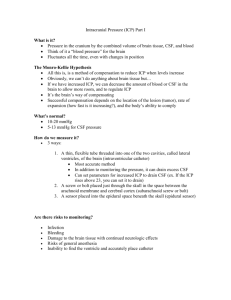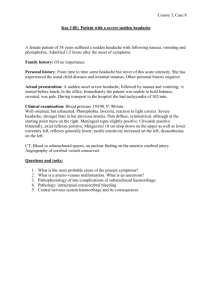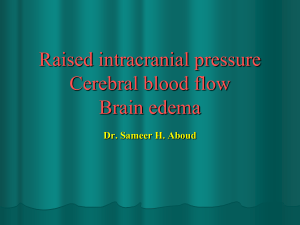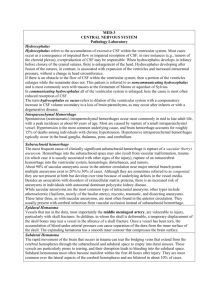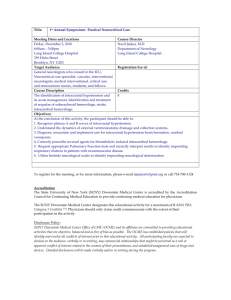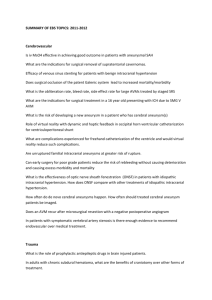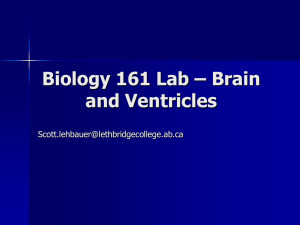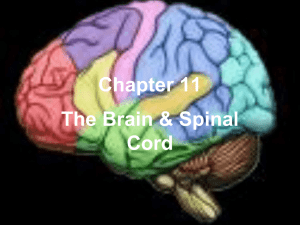Neuroanatomy Ch 5 126-159 [4-20
advertisement
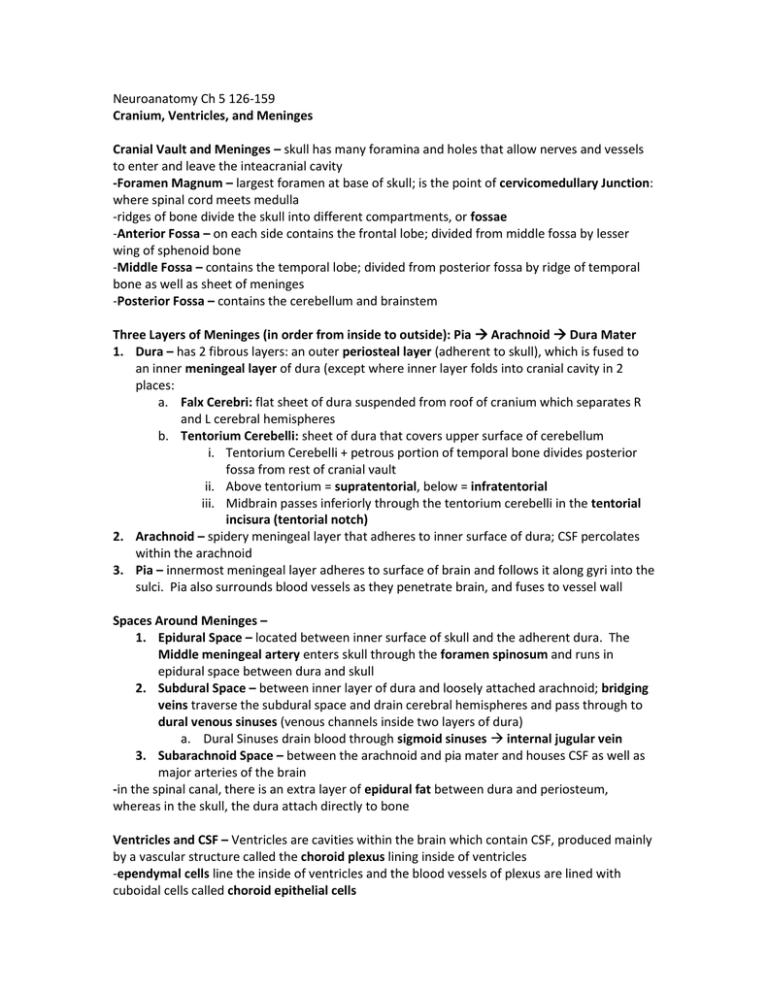
Neuroanatomy Ch 5 126-159 Cranium, Ventricles, and Meninges Cranial Vault and Meninges – skull has many foramina and holes that allow nerves and vessels to enter and leave the inteacranial cavity -Foramen Magnum – largest foramen at base of skull; is the point of cervicomedullary Junction: where spinal cord meets medulla -ridges of bone divide the skull into different compartments, or fossae -Anterior Fossa – on each side contains the frontal lobe; divided from middle fossa by lesser wing of sphenoid bone -Middle Fossa – contains the temporal lobe; divided from posterior fossa by ridge of temporal bone as well as sheet of meninges -Posterior Fossa – contains the cerebellum and brainstem Three Layers of Meninges (in order from inside to outside): Pia Arachnoid Dura Mater 1. Dura – has 2 fibrous layers: an outer periosteal layer (adherent to skull), which is fused to an inner meningeal layer of dura (except where inner layer folds into cranial cavity in 2 places: a. Falx Cerebri: flat sheet of dura suspended from roof of cranium which separates R and L cerebral hemispheres b. Tentorium Cerebelli: sheet of dura that covers upper surface of cerebellum i. Tentorium Cerebelli + petrous portion of temporal bone divides posterior fossa from rest of cranial vault ii. Above tentorium = supratentorial, below = infratentorial iii. Midbrain passes inferiorly through the tentorium cerebelli in the tentorial incisura (tentorial notch) 2. Arachnoid – spidery meningeal layer that adheres to inner surface of dura; CSF percolates within the arachnoid 3. Pia – innermost meningeal layer adheres to surface of brain and follows it along gyri into the sulci. Pia also surrounds blood vessels as they penetrate brain, and fuses to vessel wall Spaces Around Meninges – 1. Epidural Space – located between inner surface of skull and the adherent dura. The Middle meningeal artery enters skull through the foramen spinosum and runs in epidural space between dura and skull 2. Subdural Space – between inner layer of dura and loosely attached arachnoid; bridging veins traverse the subdural space and drain cerebral hemispheres and pass through to dural venous sinuses (venous channels inside two layers of dura) a. Dural Sinuses drain blood through sigmoid sinuses internal jugular vein 3. Subarachnoid Space – between the arachnoid and pia mater and houses CSF as well as major arteries of the brain -in the spinal canal, there is an extra layer of epidural fat between dura and periosteum, whereas in the skull, the dura attach directly to bone Ventricles and CSF – Ventricles are cavities within the brain which contain CSF, produced mainly by a vascular structure called the choroid plexus lining inside of ventricles -ependymal cells line the inside of ventricles and the blood vessels of plexus are lined with cuboidal cells called choroid epithelial cells -there are 2 lateral ventricles, a third ventricle inside the diencephalon, and the fourth ventricle which is surrounded by pons, medulla, and cerebellum 1. Lateral Ventricles – largest ventricles within the cerebral hemispheres possessing extensions called horns named after the lobes or direction in which they extend a. Frontal Horn – extends frontal lobe; anterior to interventricular foramen of monro b. Body – Posterior to interventricular formamen of Monro; within frontal/parietal lobes c. Atrium – area of convergence of occipital/temporal horns and body of lat. Ventricle d. Occipital Horn – extends from atrium posteriorly into occipital lobe e. Temporal horn – extends from atrium inferiorly into temporal lobe 2. Third Ventricle – within the thalamus and hypothalamus (formed by walls of these) 3. Fourth Ventricle – within the pons, medulla, and cerebellum C-shaped structures – caudate nucleus, corpus callosum, fornix, and stria terminalis follow the shape of the lateral ventricles -lateral ventricles communicate with the 3rd ventricle through interventricular foramen of Monro -3rd ventricle communicates with the 4th ventricle via the cerebral aqueduct (aqueduct of Sylvius), which travels through the midbrain CSF leaves ventricular system through foramina in the 4th ventricle: lateral foramina of Luschka and the midline foramen of Magendie -CSF percolates through brain and spinal cord and is reabsorbed by arachnoid granulations into dural venous sinuses and back into blood -TOTAL VOLUME of CSF is 150cc; produced by choroid plexus at 20cc/hour -subarachnoid space widens in areas to form larger CSF collections called cisterns: 1. Perimesencephalic cisterns a. Ambient Cistern – lateral to midbrain b. Quadrigeminal Cistern – posterior to midbrain, beneath corpus callosum c. Interpeduncular Cistern – ventral surface of midbrain between cerebral peduncles; CN III exits midbrain through interpeduncular fossa 2. Prepontine Cistern – ventral to the pons; contains basilar artery and CN VI 3. Cisterna Magna – largest cistern under cerebellum and near foramen magnum 4. Lumbar Cistern – in lumbar region of cord, contains cauda equine; lumbar puncture Blood-Brain Barrier (BBB) – normal capillaries lined with clefts/fenestrations to allow free passage of fluids and solutes; in brain the capillary endothelial cells are lined with tight junctions, and so substances must travel through endothelial cells to reach the brain -lipid-soluble substances like O2 and CO2 can cross BBB, but other substances need to be transported across by active transport, facilitated diffusion, ion exchange, and ion channels -CSF is reabsorbed at the arachnoid granulations where arachnoid villus cells Circumventricular Organs – areas in the brain where the BBB is disrupted, allowing brain to respond to changes in chemical milieu of remainder of body and to secrete neuromodulatory peptides into bloodstream -best known is the median eminence and the neurohypophysis involved in releasing pituitary hormones -Area Postrema – only paired circumventricular organ along the caudal wall of 4th ventricle and medulla (chemotactic trigger zone) involved in detecting circulating toxins that cause vomiting -Pineal – involved in melatonin-related circadian rhythms -Vasogenic Edema – excessive extracellular fluid due to disruption of BBB causing fluid extravasation -Cytotoxic Edema – cellular damage, such as in cerebral infarction, can cause excessive intracellular fluid accumulation within brain cells Headache – headache is caused by mechanical traction, inflammation, or irritation of other structures in the head that are innervated, including blood vessels, meninges, scalp, skull -side of the headache often corresponds to the side of pathology -most headaches can be classified as either a vascular headache or tension headache 1. Vascular Headache – can mean migraine as well as cluster headache; thought to involve inflammatory, autonomic, or other influences on blood vessels in the head a. Migraine – may be genetic, symptoms provoked by foods, stress, eye strain, etc… Often preceded by aura involving visual blurring, shimmering, scintillating distortions, or fortification scotoma (region of visual loss bordered by zigzagging lines resembling walls of a fort. i. Often unilateral, throbbing pain exacerbated by light or sound ii. Treated with NSAIDS, anti-emetics, triptans, b. Complicated Migraine – accompanied by transient focal neurologic deficits, including sensory phenomena, motor deficits, visual loss, brainstem findings in basilar migraine, and impaired eye movements in ophthalmoplegic migraine c. Cluster Headache – 5x more common in males; clusters of severe headaches occur from once to several times/day every day (steady, boring in one eye), accompanied by unilateral tearing, eye redness, Horner’s Syndrome, flushing, sweating 2. Tension Headache – steady dull ache (bandlike sensation) related to excessive contraction of scalp and neck muscles; some patients occur continuously for days/years associated with psychological stress a. Posttraumatic Headache – chronic daily tension headache b. Treatment – muscle relaxation, NSAIDs, analgesics -low-CSF pressure can occur spontaneously or following lumbar puncture -Idiopathic Intracranial Hypertension – condition characterized by headache an elevated intracranial pressure with no mass leasion; adolescent females and treated with acetazolamide -Temporal Arteritis – treatable cause of headache in elderly- vasculitis affects temportal arteries and other vessels including those supplying the eye -temporal artery enlarged and firm -diagnosis is made by measurement of blood erythrocyte sedimentation rate Intracranial Mass Lesions – tumor, hemorrhage, abscess, edema, hydrocephalus; mechanisms: 1. compression + destruction of adjacent regions of brain can cause neurologic abnormalities 2. mass in the cranial vault can raise intracranial pressure 3. mass lesions can displace CNS structures such that they move from one compartment to another, called herniation Mass Effect – any distortion of normal brain geometry due to mass lesions -mass effect can be subtle flattening (effacement) with no symptoms, but can also produce local damage; lesion in primary motor cortex will cause contralateral weakness; if lesion distorts/irritates meninges or blood vessels, can cause headache, infarction, or erosion -Disruption of BBB – results in extravasation of fluid into extracellular space producing vasogenic edema -Compression of Ventricular Systems – can obstruct CSF flow to produce hydrocephalus -Cerebral Cortex – lesions can provoke abnormal electrical discharges to cause seizures -large masses can produce midline shift of structures away from side of lesion -displacement of brain stem impairs function of reticular activating systems to cause impaired consciousness and coma Elevated Intracranial Pressure – small lesions can be accommodated by decrease in intracranial CSF and blood without rise in pressure; large lesions overcome this raise intracranial pressure which can lead to herniation and death -cerebral blood flow depends on cerebral perfusion pressure (CPP) which is defined as mean arterial pressure minus intracranial pressure (CPP = MAP – ICP); as intracranial pressure increases, cerebral perfusion pressure decreases -Autoregulation – of cerebral vessel caliber can compensate for modest reduction perfusion pressure -large increases in intracranial pressure exceeds capacity of autoregulation leading to ssdecreased cerebral blood flow and ischemia Symptoms and Signs of Elevated Intracranial Pressure 1. Headache – often worse in the morning since brain edema increases overnight from gravity 2. Altered Mental Status – irritability and depressed alertness/attention (MOST IMPORTANT) 3. Nausea/Vomiting – vomiting can occur without nausea, called projectile vomiting 4. Papilledema – elevation of optic disc w/ retinal hemorrhages (chronic condition) a. Can lead to blurring or visual loss; areas of loss are called increased blind spot or a concentric visual field deficit affecting peripheral margins of visual field b. Diplopia can occur as a result of downward traction on CN VI, causing unilateral or bilateral abducens nerve palsies 5. Cushing’s Triad – hypertension, bradycardia, and irregular respirations -Normal intracranial pressure is <20cmH2O or <15mmHg Treatment of Elevated Cranial Pressure – 1. Elevate head of bed 30 degrees and maintain head straight – immediate effect to promote venous drainage 2. Intubate and hyperventilate to pCO2 of 25-30mmHg, works in 30 seconds to cause cerebral vasoconstriction 3. IV mannitol works in 5 minutes to promote removal of edema from CNS while maintaining perfusion 4. Ventricular drainage – decreases intracranial pressure 5. Barbiturate-induced coma – cause cerebral vasoconstriction + reduced metabolic demand 6. Hemicraniectomy – decompresses intracranial cavity 7. Steroids – reduces cerebral edema possibly by strengthening BBB Brain Herniation Syndromes – occurs when mass effect is severe enough to push structures from one compartment to another 1. Transtentorial Herniation – herniation of medial temporal lobe, especially the uncus inferiorly through the tentorial notch a. Uncal herniation is heralded by clinical triad: blown pupil, hemiplegia, and coma; dilated pupil is ipsilateral to lesion in 85% of cases b. Compression of cerebral peduncles can cause hemiplegia (paralysis on half the body); contralateral to lesion. In cases of uncal herniation, the midbrain is pushed all the way until it is compressed by opposite side of tentorial notch, producing hemiplegia ipsilateral to lesion because the contralateral corticospinal tract is compressed (Kernohan’s phenomenon) c. Distortion of midbrain reticular formation leads to decreased consciousness/coma 2. Central Herniation – downward displacement of brainstem caused by any lesion associated with increased intracranial pressure (hydrocephalus or edema) a. Can cause traction on CN VI to produce lateral rectus palsy (uni or bilateral) b. Significant central herniation causes bilateral uncal herniation c. Herniation of cerebellar tonsils down through foramen magnum is called tonsillar herniation and is associated with compression of medulla leading to respiratory arrest, blood pressure instability, and death. 3. Subfalcine Herniation – unilateral mass lesions can cause cingulate gyrus and other brain structures to herniate under falx cerebri from one side of cranium to the other; no symptoms other than occasional infarct to anterior cerebral artery Head Trauma – mild head trauma causes concussion, which is reversible impairment of neurologic function for a period of minutes to hours following a head injury -clinical features are loss of consciousness, headache, dizziness, nausea, vomiting – occasionally followed by anterograde/retrograde amnesia -CT/MRI findings are normal -some patients recover completely but develop postconcussive syndrome with headaches, lethargy, mental dullness -more severe head trauma can cause permanent damage to brain through many mechanisms: 1. Diffuse axonal Shear Injury – causes widespread or patchy damage to white matter and CN 2. Petechial Hemorrhages – small spots of blood in white matter 3. Intracranial Hemorrhages 4. Cerebral Contusion and direct tissue injury by penetrating trauma such as gunshot wound 5. Cerebral edema may occur as well Intracranial Hemorrhage – can be traumatic or atraumatic and can occur in several cranial compartments within cranium 1. Epidural Hematoma – occurs between the dura and the skull caused by rupture of the middle meningeal artery due to fracture of TEMPORAL bone by head trauma a. Rapid expanding hemorrhage peels dura away from inner surface of skull to form lens-shaped biconvex hematoma that does NOT spread past sutures b. Causes intracranial pressure increase and death unless treated 2. Subdural Hematoma – occurs in space between dura and arachnoid and caused by rupturing of the bridging veins which are vulnerable to shear injury. Spreads out to form crescent shaped hematoma; two types a. Chronic Subdural Hematoma – seen in elderly where venous blood can collect slowly over a period of weeks; can result in headache, cognitive impairment and unsteady gait b. Acute Subdural Hematoma – impact velocity must be high and is associated with other injuries such as subarachnoid hemorrhage and brain contiusion c. Acute blood is hyperdense and bright on CT scan; after 2 weeks clot liquefies and becomes isodense; can become hypodense if no further bleeding; with mixed density hematomas, denser blood settles to bottom giving it the hematocrit effect 3. Subarachnoid Hemorrhage – occurs in CSF filled space between arachnoid and pia which contains major blood vessels of brain; blood can be seen on CT inside the sulci of pia; caused by nontraumatic and traumatic experiences a. Nontraumatic Subarachnoid Hemorrhage – spontaneous hemorrhage presents with catastrophic headache “worst headache of my life” and occurs from rupture of arterial aneurysm in subarachnoid space; less often it results from bleeding of an arteriovenous malformation i. risk factors include atherosclerotic disease, congenital anomalies, renal dysx ii. Saccular Aneurisms – arise from arterial branch points near circle of Willis and are balloon-like outpouchings of vessel wall that typically have neck conneted to parent vessel and a fragile dome that can ruptures; most common locations are anterior communicating artery, PCA, and MCA iii. Lumbar Puncture should be performed in suspected subarachnoid hemorrhage with negative CT but not positive CT because increased transmural pressure across aneurysm can precipitate rebleeding iv. Cerebral Vasospasm occurs in 50% of patients in nontraumatic cases b. Traumatic Subarachnoid Hemorrhage – caused by bleeding into CSF from damaged vessels associated with cerebral contusions and other traumatic injuries; more common than spontaneous subarachnoid hemorrhage and is associated with severe headache due to meningeal irritation i. Cerebral vasospasm DOES NOT OCCUR 4. Intracerebral/Intraparenchymal Hemorrhage – occurs within brain parenchyma in cerebral hemispheres, brain stem, cerebellum, or spinal cord; traumatic or nontraumatic a. Traumatic Intracerebral Hemorrhage – CONTUSIONS of hemispheres occur in regions where cortical gyri abut the ridges of skull, and are most common at temporal and frontal poles; contusions occur on side of impact (coup injury) or opposite side of impact (contrecoup injury) because of rebound b. Nontraumatic Intracerebral Hemorrhage – hypertension, tumors, secondary hemorrhage, vascular malformations, coagulation abnormalities, infections, etc… i. Hypertensive hemorrhage – MOST COMMON CAUSE – involves small, penetrating vessels such as lenticulostriate arteries, such as lipohyalinosis and microaneurysms of Charcot-Bouchard 1. Most common locations: basal ganglia, thalamus, cerebellum, pons 2. Some may involve ventricles, either by extending from adjacent parenchyma or arising from blood vessels in ventricles called intraventricular extension or hemorrhage, respectively ii. Lobar Hemorrhage – bleeding involves occipital, parietal, temporal, or frontal lobe; MOST COMMON CAUSE is amyloid angiopathy caused by amyloid buildup of vessel walls c. Vascular Malformations – can cause intracranial hemorrhage, classified as: i. Arteriovenous Malformations – congenital, abnormal connections between arteries and veins forming tangle of abnormal vessels ii. Cavernomas – abnormally dilated blood vessels lined by only one layer of vascular endothelium iii. Capillary Telangiectasis – small regions of abnormally dilated capillaries can rarely give rise to intracranial hemorrhage; iv. Developmental venous anomalies are dilated veins seen on MRI as single flow void extending to brain surface, don’t cause symptoms Hydrocephalus – caused by excess CSF in intracranial cavity and can result from excess CSF production, obstruction of flow at any point in ventricles or subarachnoid space, or decrease in reabsorption via arachnoid granulations 1. Excess CSF Production – rare and seen only with tumors: such as choroid plexus papilloma 2. Obstruction of CSF Flow – common cause of hydrocephalus produced by obstruction of ventricular system by tumors, intraparenchymal hemorrhage, masses, and congenital issues a. Can occur anywhere along path of CSF flow, but especially at foramen of Monro, cerebral aqueduct of Sylvius, and fourth ventricle 3. Decreased CSF reabsorption – cause hydrocephalus when the arachnoid granulations are damaged or clogged -Hydrocephalus is classified into two categories: Communicating Hydrocephalus – caused by impaired CSF reabsorption in the arachnoid granulations, obstruction of flow in subarachnoid space, or excess CSF production Noncommunicating Hydrocephalus – caused by obstruction of flow within ventricles Symptoms of Hydrocephalus – similar to elevated intracranial pressure and can be acute/chronic depending on how quickly hydrocephalus develops -symptoms can be headache, nausea, vomiting, cog. impairment, decreased level of consciousness, papilledema, decreased vision, CN VI palsies -Unsteady magnetic gait (feet barely leave floor) -Eye movement abnormalities occur; in slow cases, only CN VI palsies can be seen, which shows incomplete or slow abduction of eye in horizontal direction -severe hydrocephalus can cause inward deviation of 1 or both eyes or dilation of suprapineal recess of posterior third ventricle can push downward onto collicular plate of midbrain to produce Parinaud’s Syndrome Treatment Options – allows CSF to bypass the obstruction and drain -external ventricular drain (ventriculostomy) drains fluid from lateral ventricles into bag outside the head -ventriculoperitoneal shunt – shunt bypasss from lateral ventricle out of the skull and tunneled under skin to drain into peritoneal cavity -Endoscopic neurosurgery – narrow tube placed into cranium or spine through incision to treat obstructive hydrocephalus and intraventricular mass lesions -Third Ventriculostomy – alternative to shunting, where an endoscope is passed through foramen of Monro into third ventricle and a perforation in the floor is made allowing CSF to drain into interpeduncular cistern Normal Pressure Hydrocephalus – chronically dilated ventricles presenting with clinical triad of gait difficulty, urinary incontinence, and mental decline Hydrocephalus ex vacuo – excess CSF in region where brain was lost due to stroke, surgery, atrophy, or trauma Brain Tumors – two categories: Primary CNS Tumors arising from abnormal proliferation of cells originating in CNS and Metastatic tumors arising elsewhere that spread to the brain Gliomas – subdivided into several different types: 1. Astrocytomas – classified from benign to grade IV (glioblastoma multiforme) 2. Meningiomas – arise from arachnoid villus cells and occer over lateral convexities, in the falx, and basal regions of cranium. Slow growing. 3. Pituitary Adenomas – cause endocrine disturbances and can result in bitemporal visual field defect 4. Schwannomas – most common in CN VIII 5. Lymphoma – of CNS is common with HIV and arises from B lymphocytes and involves regions adjacent to ventricles and diagnosed from CSF cytology 6. Pineal Region Tumors – include pinealomas, germinoma, and teratoma; may obstruct cerebral aqueduct to cause hydrocephalus or may compress dorsal midbrain to cause Parinaud’s syndrome 7. Metastases – three most common are lung, breast, and melanoma; some can hemorrhage In pediatric patients, most common brain tumors are posterior fossa astrocytoma, medulloblastoma, and ependymoma Cerebellar Astrocytoma is a type of grade I astrocytoma can often be cured Medulloblastoma and ependymoma of posterior fossa has worse prognosis

